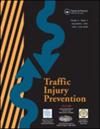Is there a difference in crash self-reports between electric and conventional motorcycles in Vietnam?
IF 1.9
3区 工程技术
Q3 PUBLIC, ENVIRONMENTAL & OCCUPATIONAL HEALTH
引用次数: 0
Abstract
Objectives
Understanding the risks associated with electric motorcycles (EMs) is essential for developing effective mobility and safety strategies in an era of increasing motorcycle use and the shift toward electric vehicles. In this research, we investigate the prevalence of crashes among EM and conventional motorcycle (CM) users, as well as factors contributing to the crashes.
Methods
This study uses primary survey data from 972 motorcyclists (481 EM and 491 CM riders) collected in December 2023 in Hanoi, Vietnam. It compares the frequency of risky riding behaviors and crash types between the 2 groups. Additionally, 2 binary logit regression models are applied to identify factors associated with crashes in the past 12 months for EM and CM riders.
Results
The results suggest that the prevalence of respondents who did not experience crashes (56.1%), minor crashes (68.8%), serious crashes with injury (80.9%), and hospitalization (91.1%) for EM riders was significantly higher than that for CM users. CM riders tend to engage in many risky riding behaviors more frequently than EM riders. Higher frequencies of speeding, smoking, and neglecting turn signals were related to greater crash risk in both groups. Red light running was a particular risk factor of crash prevalence for EMs only. Older EM users were more likely to experience a crash, and CM users traveling longer and living in urban districts were found to be linked to higher crash prevalence.
Conclusions
Transitioning from CMs to EMs in Vietnam may offer some safety benefits, such as cautious behavior by EM riders and lower speeds, but there are no major differences in crash prevalence between the groups. Risky behaviors like speeding, smoking, and neglecting turn signals increase crash risks for both; red light running is a particular concern for EM riders and longer travel distances and urban residency for CM users. Targeted interventions, proper training, and licensing are essential, with attention to older EM riders’ vulnerabilities and the risks faced by CM users in urban areas and on long trips.
越南电动摩托车和传统摩托车的碰撞自我报告有区别吗?
目标:了解与电动摩托车(EMs)相关的风险对于在摩托车使用日益增加和向电动汽车转变的时代制定有效的机动性和安全策略至关重要。在这项研究中,我们调查了车祸在新兴市场和传统摩托车(CM)用户中的流行程度,以及导致车祸的因素。方法:本研究使用了2023年12月在越南河内收集的972名摩托车手(481名EM骑手和491名CM骑手)的主要调查数据。它比较了两组之间危险骑行行为的频率和碰撞类型。此外,我们还应用了2个二元logit回归模型来识别过去12个月与新兴市场和新兴市场车手撞车事故相关的因素。结果:调查结果显示,未发生碰撞(56.1%)、轻微碰撞(68.8%)、严重碰撞(80.9%)和住院(91.1%)的受访者中,EM骑行者的患病率显著高于CM骑行者。CM骑手比EM骑手更倾向于从事许多危险的骑行行为。在两组中,超速、吸烟和忽视转向信号的频率越高,碰撞风险越大。闯红灯是一个特殊的危险因素,事故发生率仅为急诊。年龄较大的EM用户更有可能经历撞车事故,而CM用户旅行时间更长,生活在城市地区,被发现与更高的撞车发生率有关。结论:在越南,从CMs向EMs的过渡可能会带来一些安全方面的好处,例如EM乘客的谨慎行为和较低的速度,但两组之间的碰撞发生率没有重大差异。超速、吸烟和忽视转向灯等危险行为会增加两者的撞车风险;闯红灯是新兴市场乘客特别关心的问题,而长途旅行和城市居住则是普通汽车用户的问题。有针对性的干预、适当的培训和许可是至关重要的,要关注老年新兴市场乘客的脆弱性,以及城市地区和长途旅行中新兴市场用户面临的风险。
本文章由计算机程序翻译,如有差异,请以英文原文为准。
求助全文
约1分钟内获得全文
求助全文
来源期刊

Traffic Injury Prevention
PUBLIC, ENVIRONMENTAL & OCCUPATIONAL HEALTH-
CiteScore
3.60
自引率
10.00%
发文量
137
审稿时长
3 months
期刊介绍:
The purpose of Traffic Injury Prevention is to bridge the disciplines of medicine, engineering, public health and traffic safety in order to foster the science of traffic injury prevention. The archival journal focuses on research, interventions and evaluations within the areas of traffic safety, crash causation, injury prevention and treatment.
General topics within the journal''s scope are driver behavior, road infrastructure, emerging crash avoidance technologies, crash and injury epidemiology, alcohol and drugs, impact injury biomechanics, vehicle crashworthiness, occupant restraints, pedestrian safety, evaluation of interventions, economic consequences and emergency and clinical care with specific application to traffic injury prevention. The journal includes full length papers, review articles, case studies, brief technical notes and commentaries.
 求助内容:
求助内容: 应助结果提醒方式:
应助结果提醒方式:


